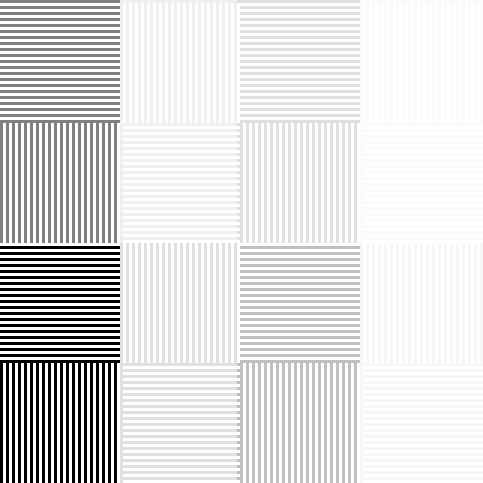I’ve had some e-mail correspondence that suggests something about the Epson inkjet hardware and software: That Epson has, in my words, dumbed down the traditional error diffusion dither algorithm so that it can’t represent detail finer than 720 pixels per inch at 2880 DPI resolution, or finer than 360 pixels per inch at 1440 DPI resolution. I don’t know why they would do this except to make the computation less complex. I also received a suggestion to use a scanner as a digital microscope to see what’s really going on with the printer.
In hopes of gaining more information about the printer and the driver, I took the scanner suggestion to heart and created the following test pattern, consisting of a white background with one pixel wide horizontal and vertical stripes in black and various shades of gray. The idea of the various shades of gray is to be able to look at lightly-inked areas in the image to be able to see what’s going on with individual ink droplets.
Here’s the overall test pattern; it looks blurry because of the JPEG compression:

I sent the test pattern to an Epson 3880, using Epson Photo Paper Glossy, advanced black and white print controls, and 2880/1440 resolution. I scaled the pattern to 360, 720, and 1440 pixels per inch, which gave, respectively, one ad, 360, and 720, line pairs per inch. I scanned the resulting prints using an Epson V700 scanner at 12800 pixels per inch resolution (not real resolution, but interpolated).
Here’s the result at 360 ppi input.
That’s about what I’d expect. But the results at 720 ppi were a surprise (note that the magnification is double that of the 360 ppi image because the image is half the size):
There are two odd things. The first is that there is no evidence of the grating. The second is that the areas of lightly inked vertical stripes are way lighter than they should be.
In order to figure out what was going on, I looked at the printed patterns under a microscope.
Here is a section of the 360 ppi print.
And here’s a section of the same print showing the vertical stripes:
Almost all the dots are the smallest the printer can deliver because we’re looking at a light part of the pattern. The dots appear to be about one thousandth of an inch in diameter, or maybe a little smaller. The dots appear to have a minimum spacing of about 300 millionths of an inch in the vertical dimension, and about 600 millionths of an inch in the horizontal direction, although most of the time, the spacing is twice that or more. In any case, the dots appear to be small enough and the printer resolution high enough to easily resolve a 720 ppi grating, but the printer turns that fine a pattern into a gray mush.
So, the email was right about Epson dumbing down the hardware/software combination over what is achievable using conventional error diffusion. The situation is even worse than the correspondent thought, since, even with the highest resolution of which the printer is capable, it can’t resolve a 720 ppi grating.
My first impulse is to blame the Epson driver. Unless I try a third-party RIP, I won’t really know.




Leave a Reply